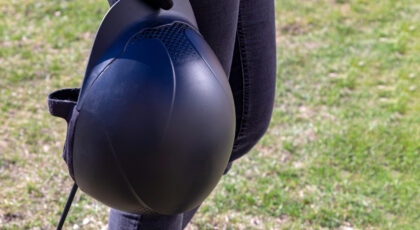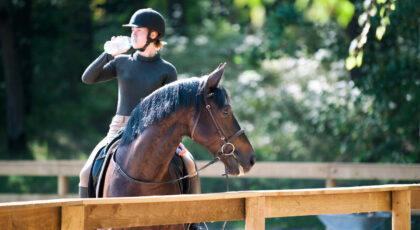Dogma has always been a curious phenomenon to me.
In the horse world, people often get dogmatic, from the “best” way to feed a horse, to the “proper” way to ride, shoe, groom, etc. Dogma is usually expressed in terms of things that someone should always—or never—do, and it’s often at odds with what’s known, often dramatically so.
Let’s talk about something you should probably never do: jumping out of an airplane from 20,000 feet without a parachute. It’s not a good idea, in terms of one’s longevity. There are a lot of reasons for this but in its simplest terms, the risk is just too great.
We try to avoid risk in just about everything, and not only in the horse world, of course. Risk avoidance is why riding helmets are a great idea, as are the projective jackets used in the eventing world. Riding horses represents a risk, and we do things to try to mitigate that risk.
Of course, if horse riding were uniformly fatal—like jumping parachute-less from up in the clouds—my guess is that very few people would do it. But for people that love riding horses, the risk is worth the many benefits (emotional, physical, etc.).
Which brings me to two of the three subjects of this article: bute and dex.
Bute (short for phenylbutazone) is arguably the most commonly prescribed non-steroidal anti-inflammatory and pain relieving drug (NSAID) in the horse world, at least in the United States.
Dex (the nickname for dexamethasone, a commonly used steroidal anti-inflammatory drug) is one of the most commonly used pharmaceutical agents used to treat inflammation, including that caused by allergies.
It would be pretty hard to practice effective horse medicine without NSAIDs and corticosteroid medications such as dex. Nevertheless, not a week goes by when I don’t hear dogmatic statements about these two pharmaceuticals:
- “Don’t use bute. You’ll destroy the horse’s stomach. Or his kidneys. Or both.”
- “Don’t use dex. You’ll give the horse laminitis.”
Risk, as you might have guessed, is the third subject to discuss, and it’s the driving factor behind therapeutic dogma. Risk usually comes in one of two types: relative and absolute. When it comes to assessing whether you want to do something to your horse (or to you), it’s important to know the difference.
An absolute risk is a risk that is pretty much guaranteed. Take the jumping-out-of-the-plane example. The law of gravity is rather prickly when it comes to the risks involved. You’re going to get pulled right smack into the ground; scientists even know what your terminal velocity will be. And that big terminal “smack” is the reason why jumping out of an airplane without a parachute one afternoon means you’re almost certainly not going to make dinner that evening. The risk of a fatal outcome is pretty much absolute.
Of course, not all risks are that way. As I mentioned, horseback riding is a risk, but it’s one that horseback riders willingly take.
Or take driving. Imagine that you jump into your car, ready to drive off to work one fine morning. You buckle your seatbelt (another risk avoidance maneuver), you start the car, and you almost have a heart attack when your spouse, friend, or significant other comes running up to pound on the window, screaming, “Oh my God, what are you doing? You could be killed!”
The fact is, that caring person is completely right. But that’s not the whole story. He or she is absolutely right about a relative risk. The important consideration here is not that there’s an absolute risk—I mean, to be sure, tens of thousands of people die in automobile accidents every year—but how likely it is that your death is imminent on a particular drive to the grocery store. It’s the relative risk that’s people really worry about.

That’s where this whole “Bute is toxic” or “Dex will make your horse founder” concern gets a bit overblown. There is, in fact, an association that’s been made between bute (and other NSAIDs) and stomach and kidney problems, and between dex and laminitis. But it’s like getting in the car. The important question for the horse owner should not be, “Is there a risk?” rather, it should be, “How big of a risk is it?”
It gets a little crazy-making. At routinely prescribed doses—for a 1000-pound horse, that’s two grams given once daily—side effects are almost unheard of. Ditto with dex, or other commonly used corticosteroid drugs.
Side effects can and do occur, but with judicious dosing at proper levels and intervals, they are virtually unheard of in day-to-day clinical practice. Otherwise stated, in normal horses, at routinely prescribed doses, you’re extremely unlikely to see your horse develop gastric ulcers after a few doses of bute. On the other hand, your horse is extremely likely to survive a course of dexamethasone therapy with his hooves firmly attached to the ends of his legs.
There’s a risk—you may have even had a bad experience with your own horse—but it’s not absolute.
Veterinary scientists are aware of these risks, of course. In fact, they study them. And, curiously, try as they might, they are pretty much unable to make a horse develop laminitis by giving him dex, even after repeated doses. They are pretty much unable to ruin a horse’s kidneys or make holes in his stomach by giving him judicious doses of bute (or other NSAIDs). The relative risk of problems from these two drugs is really rather remarkably small.
Of course, in horses that aren’t normal, or in doses of medication that aren’t normal, the risks go up.
That’s why if you have a horse that is having kidney problems, or is at risk for having kidney problems (such as with extreme diarrhea and dehydration), your veterinarian will be very careful before you give him an NSAID. If you have a fat old horse with Cushing’s disease (fat, old, and Cushing’s being risk factors for laminitis), your veterinarian is likely going to try to use as low a dose of dex as possible, for as short a period of time as possible. That’s why you don’t give a horse eight grams of bute. You can make risks worse if you act carelessly.

What can you do to minimize risk? Pay attention to proper doses and proper intervals. Consult with your veterinarian prior to just, “giving him some bute.” If you don’t do those sorts of things, you’ll increase the risk. Driving is made much more dangerous if you put a blindfold over your eyes. You increase the risk if you do something stupid. Dosing drugs is like that, too.
Of course, the relentless entrepreneurship that besets the horse world is only too happy to play up relative risks, making it seem as if very low relative risks are absolute. That’s why you’ll see products advertise themselves as alternatives to “dangerous” drugs, or as “natural” substances that are free of side effects (and risk).
But here’s another Ramey Rule for you; if a product or substance is advertised as being risk free, it’s also likely to be effect free, as well. When you go about trying to do things to a horse’s system, anything that has a real effect also has a potential side effect.
When it comes to assessing risks, don’t fall into the trap of thinking that all risks are equal. They’re not.
Plus, if you avoid a useful therapeutic substance because of a fear of risk, you’re still not going to be risk free. You also risk your horse’s condition getting worse, or at least not getting any better. It doesn’t matter what you do, there’s always the chance of an unanticipated outcome.
Don’t stress about whether or not there is any risk from a therapeutic choice such as bute or dex, find out what the relative risk is, and then go about your business accordingly. That approach will do both you and your horse a lot of good.
This article originally appeared on DoctorRamey.com and is reprinted here with permission.


 June 22, 2020
June 22, 2020 

























